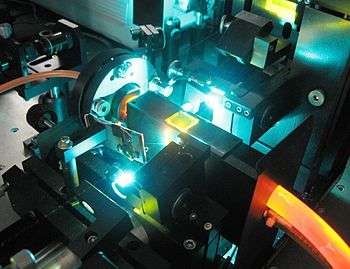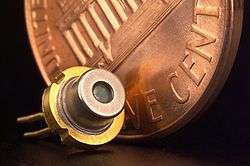Tunable laser
A tunable laser is a laser whose wavelength of operation can be altered in a controlled manner. While all laser gain media allow small shifts in output wavelength, only a few types of lasers allow continuous tuning over a significant wavelength range.

There are many types and categories of tunable lasers. They exist in the gas, liquid, and solid state. Among the types of tunable lasers are excimer lasers, gas lasers (such as CO2 and He-Ne lasers), dye lasers (liquid and solid state), transition metal solid-state lasers, semiconductor crystal and diode lasers, and free electron lasers.[1] Tunable lasers find applications in spectroscopy,[2] photochemistry, atomic vapor laser isotope separation,[3][4] and optical communications.
Types of tunability
Single line tuning
Since no real laser is truly monochromatic, all lasers can emit light over some range of frequencies, known as the linewidth of the laser transition. In most lasers, this linewidth is quite narrow (for example, the 1,064 nm wavelength transition of a Nd:YAG laser has a linewidth of approximately 120 GHz, or 0.45 nm[5]). Tuning of the laser output across this range can be achieved by placing wavelength-selective optical elements (such as an etalon) into the laser's optical cavity, to provide selection of a particular longitudinal mode of the cavity.
Multi-line tuning
Most laser gain media have a number of transition wavelengths on which laser operation can be achieved. For example, as well as the principal 1,064 nm output line, Nd:YAG has weaker transitions at wavelengths of 1,052 nm, 1,074 nm, 1,112 nm, 1,319 nm, and a number of other lines.[6] Usually, these lines do not operate unless the gain of the strongest transition is suppressed; e.g., by use of wavelength-selective dielectric mirrors. If a dispersive element, such as a prism, is introduced into the optical cavity, tilting of the cavity's mirrors can cause tuning of the laser as it "hops" between different laser lines. Such schemes are common in argon-ion lasers, allowing tuning of the laser to a number of lines from the ultraviolet and blue through to green wavelengths.
Narrowband tuning
For some types of lasers the laser's cavity length can be modified, and thus they can be continuously tuned over a significant wavelength range. Distributed feedback (DFB) semiconductor lasers and vertical cavity surface emitting lasers (VCSELs) use periodic distributed Bragg reflector (DBR) structures to form the mirrors of the optical cavity. If the temperature of the laser is changed, the index change of the DBR structure causes a shift in its peak reflective wavelength and thus the wavelength of the laser. The tuning range of such lasers is typically a few nanometres, up to a maximum of approximately 6 nm, as the laser temperature is changed over ~50 K. As a rule of thumb the wavelength is tuned by 0.08 nm/K for DFB lasers operating in the 1,550 nm wavelength regime. Such lasers are commonly used in optical communications applications such as DWDM-systems to allow adjustment of the signal wavelength. To get wideband tuning using this technique, some such as Santur Corporation or Nippon Telegraph and Telephone (NTT Corporation)[7] contain an array of such lasers on a single chip and concatenate the tuning ranges.
Widely tunable lasers

Sample Grating Distributed Bragg Reflector lasers (SG-DBR) have a much larger tunable range, by the use of vernier tunable Bragg mirrors and a phase section, a single mode output range of >50 nm can be selected. Other technologies to achieve wide tuning ranges for DWDM-systems[8] are:
- External cavity lasers using a MEMS structure for tuning the cavity length, such as devices commercialized by Iolon.
- External cavity lasers using multiple-prism grating arrangements for wide-range tunability.[9]
- DFB laser arrays based on several thermal tuned DFB lasers: Coarse tuning is achieved by selecting the correct laser bar. Fine tuning is then done thermally, such as devices commercialized by Santur Corporation.
- Tunable VCSEL: One of the two mirror stacks is movable. To achieve sufficient output power out of a VCSEL structure, lasers in the 1,550 nm domain are usually either optically pumped or have an additional optical amplifier built into the device.
As of December 2008 there is no widely tunable VCSEL commercially available any more for DWDM-system application.
It is claimed that the first infrared laser with a tunability of more than one octave was a germanium crystal laser.[10]
Applications
The range of applications of tunable lasers is extremely wide. When coupled to the right filter, a tunable source can be tuned over a few hundreds of nanometers[11][12][13] with a spectral resolution that can go from 4 nm to 0,3 nm, depending on the wavelength range. With a good enough isolation (>OD4) tunable source can be used for basic absorption and photoluminescence study. It can be used for solar cells characterisation in a light beam induced current (LBIC) experiment from which external quantum efficiency (EQE) of a device can be mapped.[14] It can also be used for the characterisation of gold nanoparticles[15] and single-walled carbon nanotube thermopile[16] where a wide tunable range from 400 nm to 1,000 nm is essential. Tunable sources were recently used for the development of hyperspectral imaging for early detection of retinal diseases where a wide range of wavelength, a small bandwidth and outstanding isolation is crucial in order to achieve an efficient illumination of the entire retina.[17][18] Tunable source can be a powerful tool for reflection and transmission spectroscopy, photobiology, detector calibration, hyperspectral imaging and steady-state pump probe experiment to name only a few.
History
The first true broadly tunable laser was the dye laser in 1966.[19][20] Hänsch introduced the first narrow-linewidth tunable laser in 1972.[21] Dye lasers and some vibronic solid-state lasers have extremely large bandwidths, allowing tuning over a range of tens to hundreds of nanometres.[22] Titanium-doped sapphire is the most common tunable solid-state laser, capable of laser operation from 670 nm to 1,100 nm wavelength. Typically these laser systems incorporate a Lyot filter into the laser cavity, which is rotated to tune the laser. Other tuning techniques involve diffraction gratings, prisms, etalons, and combinations of these.[23] Multiple-prism grating arrangements, in several configurations, as described by Duarte, are used in diode, dye, gas, and other tunable lasers.[24]
See also
References
- F. J. Duarte (ed.), Tunable Lasers Handbook (Academic, 1995).
- W. Demtröder, Laser Spectroscopy: Basic Principles, 4th Ed. (Springer, Berlin, 2008).
- J. R. Murray, in Laser Spectroscopy and its Applications, L. J. Radziemski, R. W. Solarz, and J. A. Paisner (Eds.) (Marcel Dekker, New York, 1987) Chapter 2.
- M. A. Akerman, Dye-laser isotope separation, in Dye Laser Principles, F. J. Duarte and L. W. Hillman, Eds. (Academic, New York, 1990) Chapter 9.
- Koechner, §2.3.1, p49.
- Koechner, §2.3.1, p53.
- Tsuzuki, K.; Shibata, Y.; Kikuchi, N.; Ishikawa, M.; Yasui, T.; Ishii, H.; Yasaka, H. (2009). "Full Tunable DFB Laser Array Copackaged with InP Mach-Zehnder Modulator for DWDM Optical Communication Systems". IEEE Selected Topics in Quantum Electronics. 15: 521–527. doi:10.1109/jstqe.2009.2013972.
- Tunable Lasers at Lightreading
- P. Zorabedian, Tunable external-cavity semiconductor lasers, in Tunable Lasers Handbook, F. J. Duarte, Ed. (Academic, New York, 1995) Chapter 8.
- See photograph 3 at http://spie.org/x39922.xml
- PhotonEtc: Tunable Laser Source from 400nm to 2300nm.
- Leukos : White light compact supercontinuum systems.
- Fianium : Powerful WhiteLase Supercontinuum Sources.
- L. Lombez; et al. (2014). "Micrometric investigation of external quantum efficiency in microcrystalline CuInGa(S,Se)2 solar cells". Thin Solid Films. 565: 32–36. Bibcode:2014TSF...565...32L. doi:10.1016/j.tsf.2014.06.041.
- S. Patskovsky; et al. (2014). "Wide-field hyperspectral 3D imaging of functionalized gold nanoparticles targeting cancer cells by reflected light microscopy". Biophotonics. 8 (5): 401–407. doi:10.1002/jbio.201400025. PMID 24961507.
- St-Antoine B, et al. (2011). "Single-Walled Carbon Nanotube Thermopile For Broadband Light Detection". Nano Letters. 11 (2): 609–613. Bibcode:2011NanoL..11..609S. doi:10.1021/nl1036947. PMID 21189022.
- Shahidi AM, et al. (2013). "Regional variation in human retinal vessel oxygen saturation". Exp Eye Res. 113: 143–7. doi:10.1016/j.exer.2013.06.001. PMID 23791637.
- Tunable Lasers For Retinal Imaging.
- F. P. Schäfer (ed.), Dye Lasers (Springer, 1990)
- F. J. Duarte and L. W. Hillman (eds.), Dye Laser Principles (Academic, 1990)
- Hänsch, T. W. (1972). "Repetitively Pulsed Tunable Dye Laser for High Resolution Spectroscopy". Appl. Opt. 11 (4): 895–898. Bibcode:1972ApOpt..11..895H. doi:10.1364/ao.11.000895. PMID 20119064.
- Koechner, §2.5, pp66–78.
- F. J. Duarte and L. W. Hillman (eds.), Dye Laser Principles (Academic, 1990) Chapter 4
- F. J. Duarte, Tunable Laser Optics, 2nd Ed. (CRC, New York, 2015) Chapter 7.
Further reading
- Koechner, Walter (1988). Solid-State Laser Engineering (2nd ed.). Springer-Verlag. ISBN 978-3-540-18747-9.